
A Marian apparition is a reported supernatural appearance by Mary the mother of Jesus, or a series of related such appearances during a period of time.

Our Lady of Fátima is a Catholic title of Mary, mother of Jesus, based on the Marian apparitions reported in 1917 by three shepherd children at the Cova da Iria in Fátima, Portugal. The three children were Lúcia dos Santos and her cousins Francisco and Jacinta Marto. José Alves Correia da Silva, Bishop of Leiria, declared the events worthy of belief on 13 October 1930.

Francisco de Jesus Marto and Jacinta de Jesus Marto were siblings from Aljustrel, a small hamlet near Fátima, Portugal, who, with their cousin Lúcia dos Santos (1907–2005), reportedly witnessed three apparitions of the Angel of Peace in 1916, and several apparitions of the Blessed Virgin Mary at Cova da Iria in 1917. The title Our Lady of Fátima was given to the Virgin Mary as a result, and the Sanctuary of Fátima became a major centre of global Roman Catholic pilgrimage.

The Garabandal apparitions are apparitions of Saint Michael the Archangel and the Blessed Virgin Mary that are claimed to have occurred from 1961 to 1965 to four young schoolgirls in the rural village of San Sebastián de Garabandal in the Peña Sagra mountain range in the autonomous community of Cantabria in Northern Spain.

A weeping statue is a statue which has been claimed to have shed tears or to be weeping by supernatural means. Statues weeping tears which appear to be blood, oil, and scented liquids have all been reported. Other claimed phenomena are sometimes associated with weeping statues such as miraculous healing, the formation of figures in the tear lines, and the scent of roses. These events are generally reported by Catholics, and initially attract pilgrims, but are in most cases disallowed by the Church as proven hoaxes.
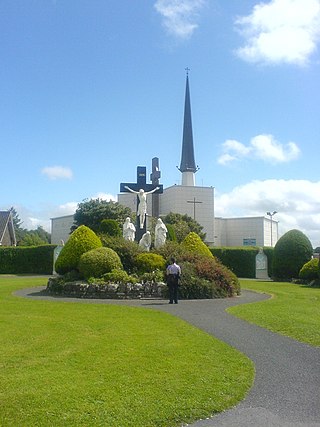
The Sanctuary of Our Lady of Knock, commonly referred to as Knock Shrine, is a Roman Catholic pilgrimage site and national shrine in the village of Knock, County Mayo, Ireland, where locals claimed to have seen an apparition in 1879 of the Blessed Virgin Mary, Saint Joseph, Saint John the Evangelist, angels, and Jesus Christ.

Our Lady of Mount Carmel, or Virgin of Carmel, is a Roman Catholic title of the Blessed Virgin Mary venerated as patroness of the Carmelite Order.

Agoo, officially the Municipality of Agoo, is a municipality in the province of La Union, Philippines. According to the 2020 census, it has a population of 66,028 people.
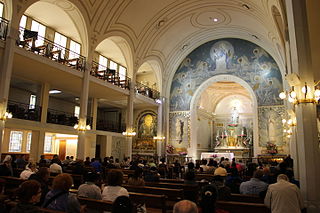
The Miraculous Medal, also known as the Medal of Our Lady of Graces, is a devotional medal, the design of which was originated by Catherine Labouré following her apparitions of the Blessed Virgin Mary in the Chapel of Our Lady of the Miraculous Medal of Paris, France.
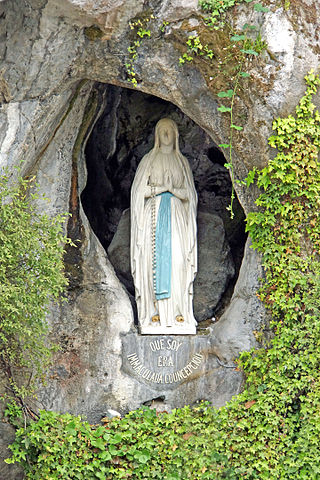
Our Lady of Lourdes is a title of the Virgin Mary. She is venerated under this title by the Roman Catholic Church due to her apparitions that occurred in Lourdes, France. The first apparition of 11 February 1858, of which Bernadette Soubirous told her mother that a "Lady" spoke to her in the cave of Massabielle while she was gathering firewood with her sister and a friend. Similar apparitions of the "Lady" were reported on 18 occasions that year, until the climax revelation in which she introduced herself as: "the Immaculate Conception". On 18 January 1862, the local Bishop of Tarbes Bertrand-Sévère Laurence endorsed the veneration of the Blessed Virgin Mary in Lourdes.

Mary, the mother of Jesus in Christianity, is known by many different titles, epithets, invocations, and several names associated with places.
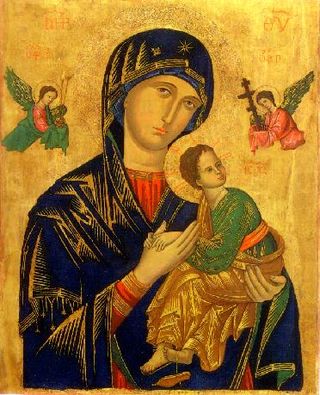
Mary has been one of the major subjects of Western art for centuries. There is an enormous quantity of Marian art in the Catholic Church, covering both devotional subjects such as the Virgin and Child and a range of narrative subjects from the Life of the Virgin, often arranged in cycles. Most medieval painters, and from the Reformation to about 1800 most from Catholic countries, have produced works, including old masters such as Michelangelo and Botticelli.

Our Lady of Akita is a title of the Blessed Virgin Mary associated with the Marian apparitions reported in 1973 by Sister Agnes Katsuko Sasagawa in the remote area of Yuzawadai, an outskirt of Akita, Japan. The messages emphasize prayer and penance in combination with cryptic prophecies warning of sacerdotal persecution and heresy within the Catholic Church. A wooden statue representing the apparitions is venerated by the Japanese faithful and other Catholics. In December 1973, a Japanese television station videotaped tears coming from the statue's eyes.

The Lady of All Nations is a Catholic Marian title sometimes associated with apparitions of the Blessed Virgin Mary to Ida Peerdeman of Amsterdam, Netherlands. Peerdeman claimed to have received 56 visions of the Lady from 1945 to 1959.
Teresita Castillo y Lat was a Filipina Catholic who said she had Marian visions. Castillo was a Discalced Carmelite postulant in the late 1940s but could not stay in the order due to the controversies surrounding the apparitions Lipa, Batangas, Philippines, in the year 1948.

Angelik Caruana is a resident of Birżebbuġa in Malta who has reported a series of visions of the Virgin Mary since 21 April 2006, including a number of times at a hill in Borġ in-Nadur where he delivered monthly messages to the public.
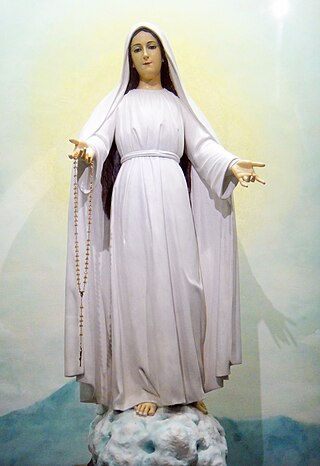
Mary, the Mediatrix of All Grace, also known as the Our Lady of Lipa, is an alleged Marian apparition that occurred within the Carmelite Monastery of Lipa, Batangas, Philippines. The event occurred to a former Carmelite postulant, Teresita Castillo. The original statue associated with the apparition is currently enshrined at the monastery.
1989 in the Philippines details events of note that happened in the Philippines in the year 1989.
Emma C. de Guzman is a Filipino Roman Catholic widow, laywoman, stigmatist and claimed Marian visionary. She is the co-founder, along with the late Sister Soledad Gaviola, of the Catholic lay group association La Pieta, dedicated to a Marian devotion under the title Mother of Love, Peace and Joy. Guzman claims to have first seen the Virgin Mary on the Feast of the Nativity of Mary in 1991.
Our Lady of the Immaculate Conception and of the Triumph of the Cross of Panguil Bay, also known as the Virgin of Cotta and The Blessed Virgin of Cotta is an 18th-century image of the Blessed Virgin Mary venerated at the Metropolitan Cathedral of the Immaculate Conception in Ozamiz City, Misamis Occidental in the Philippines and is the patroness of the city. The image was named after the Fuerte de la Concepcion y del Triunfo of Panguil Bay, the fort where it was originally kept.














